Unit 8 Our Clothes Topic 1 We will have a class fashion show.Section D课件(共28张PPT)
文档属性
| 名称 | Unit 8 Our Clothes Topic 1 We will have a class fashion show.Section D课件(共28张PPT) |
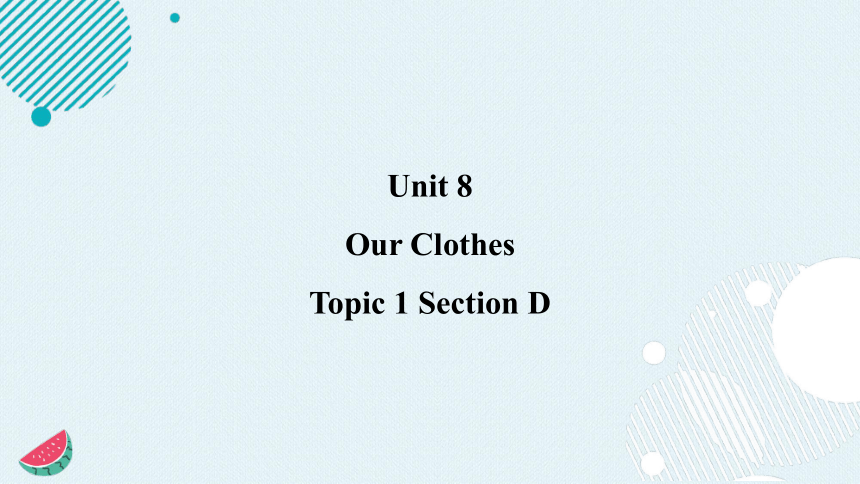
|
|
| 格式 | pptx | ||
| 文件大小 | 2.0MB | ||
| 资源类型 | 教案 | ||
| 版本资源 | 仁爱科普版 | ||
| 科目 | 英语 | ||
| 更新时间 | 2024-11-24 05:04:12 | ||
图片预览

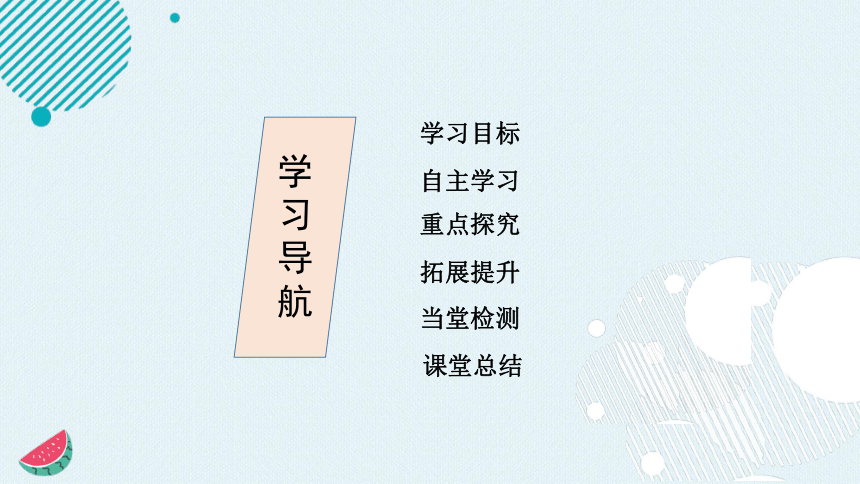
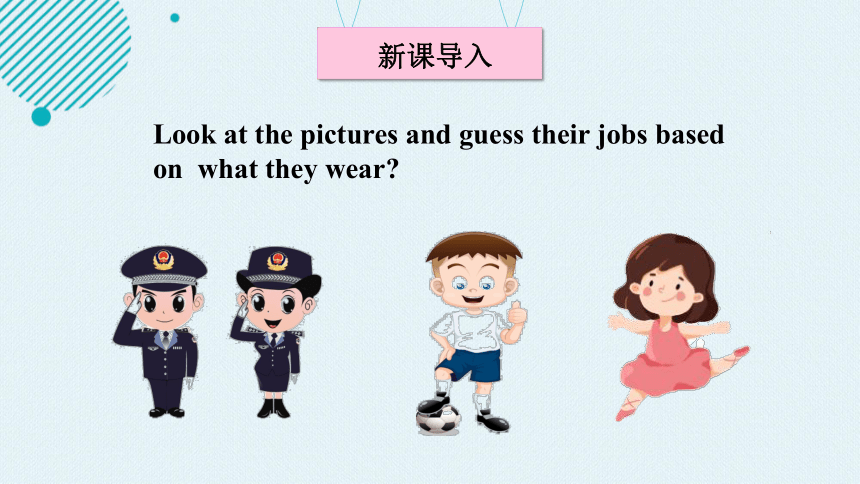
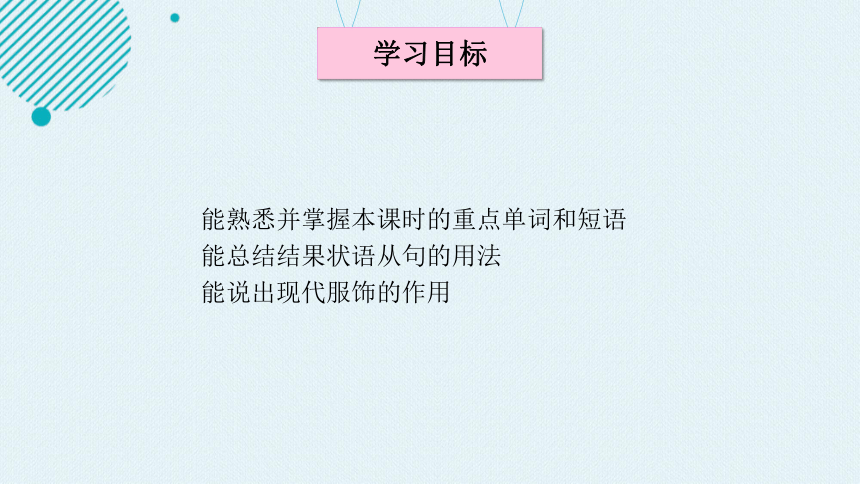
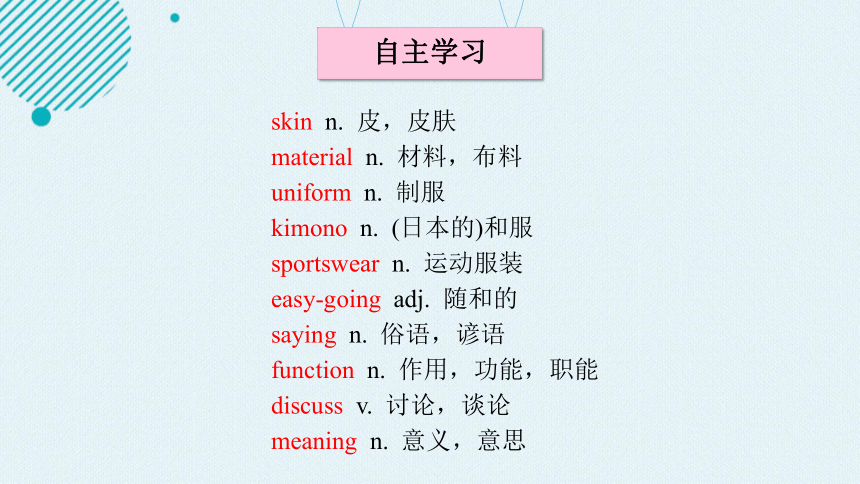
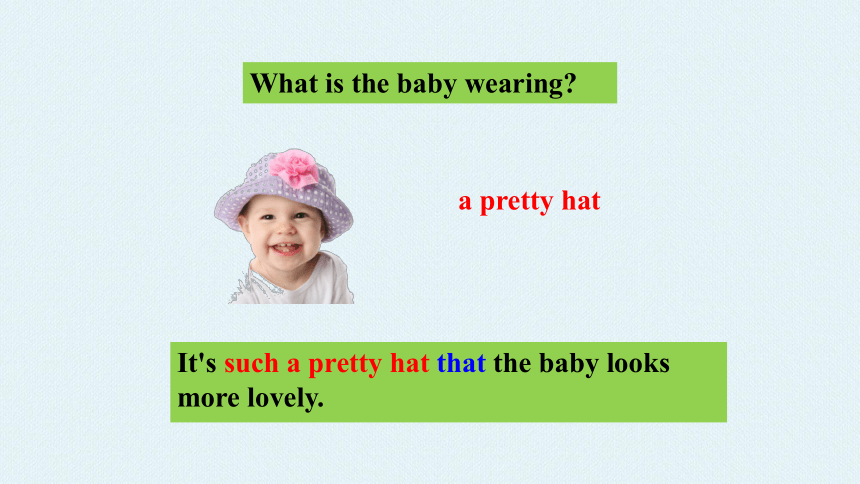
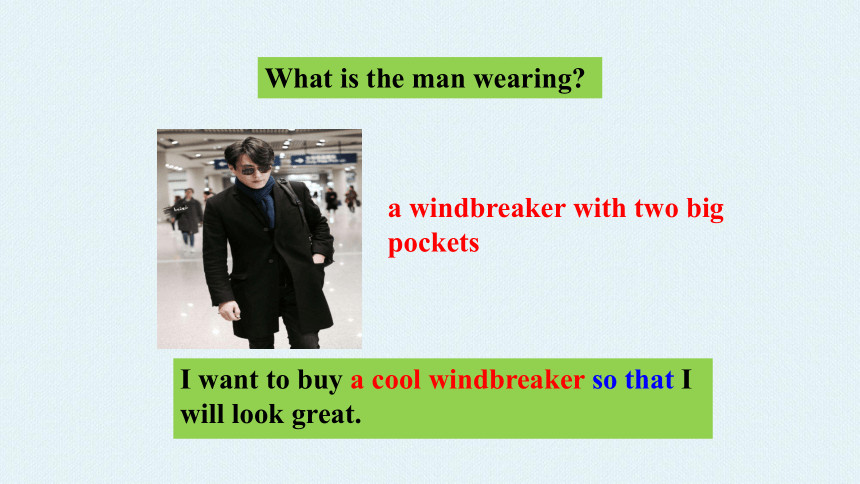
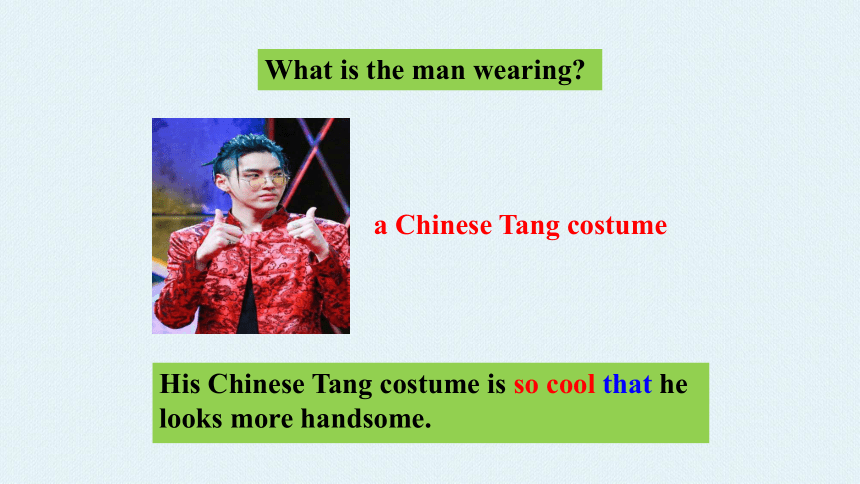
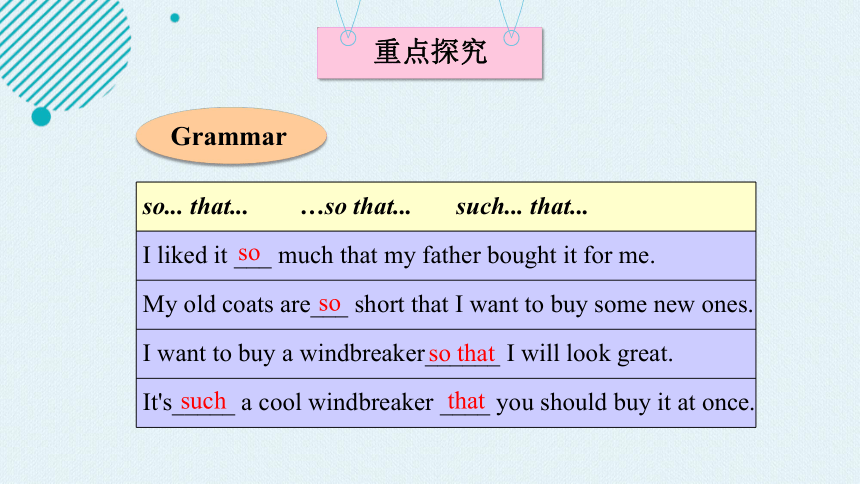
文档简介
(共28张PPT)
Unit 8
Our Clothes
Topic 1 Section D
学习目标
重点探究
自主学习
学习导航
当堂检测
课堂总结
拓展提升
新课导入
Look at the pictures and guess their jobs based on what they wear
学习目标
能熟悉并掌握本课时的重点单词和短语
能总结结果状语从句的用法
能说出现代服饰的作用
自主学习
skin n. 皮,皮肤
material n. 材料,布料
uniform n. 制服
kimono n. (日本的)和服
sportswear n. 运动服装
easy-going adj. 随和的
saying n. 俗语,谚语
function n. 作用,功能,职能
discuss v. 讨论,谈论
meaning n. 意义,意思
What is the baby wearing
a pretty hat
It's such a pretty hat that the baby looks more lovely.
What is the man wearing
a windbreaker with two big pockets
I want to buy a cool windbreaker so that I will look great.
What is the man wearing
His Chinese Tang costume is so cool that he looks more handsome.
a Chinese Tang costume
重点探究
so... that... …so that... such... that...
I liked it ___ much that my father bought it for me.
My old coats are___ short that I want to buy some new ones.
I want to buy a windbreaker______ I will look great.
It's_____ a cool windbreaker ____ you should buy it at once.
so
so
so that
such
that
Grammar
Shall we meet at the school gate at 8:00 a.m
All _____.
Excuse me,_______ you tell me where to buy a scarf
What size do you take
______ M.
right
could
Size
Functions
Look at the pictures and guess about the people based on what they wear.
The policeman is wearing uniforms.
She is in a kimono,
maybe she is Japanese.
He is wearing sportswear.
She is wearing school uniforms.
I think he is active and likes doing exercise.
Students wear uniforms at school to show good discipline.
The first types of clothes were made of animal skins. People started to wear clothes so that they could protect themselves from the sun, wind, rain and cold.
Today, we use different materials to make different kinds of clothes. But nowadays, clothes do more than just keep us warm. Clothing can also show people our jobs, our culture, our hobbies and even our moods.
1a Read and understand.
For example, when we see a man in a uniform, we can guess his job from the uniform. When we see a woman in a kimono, we may think that she is Japanese. If a man always wears sportswear, we may think he is active and likes doing exercise. If a person always wears yellow or pink clothes, maybe he or she is lively and easy-going. We get ideas about people from their clothes. As the saying goes, “You are what you wear.”
1. The first types of clothes were made of cotton.
2. People started wearing clothes only to protect themselves
from the cold.
3. People now believe that our clothes can tell others about
our moods.
4. According to the passage, quiet people like yellow or pink
clothes.
5. “You are what you wear.” means “You are wearing a kind
of clothes.”
F
F
T
F
F
Mark True (T) or False (F).
1. Why do we wear clothes
To protect us from the sun, wind, rain and cold.
2. What were the first types of clothes made of
They were made of animal skins.
3. What can our clothes tell about
They can tell people about our jobs, our culture, our
hobbies and even our moods.
4. What can we know about a person who always wears
yellow or pink clothes
We can know that maybe this person is lively and easy-
going.
Read 1a again and answer the following questions.
1. What does the passage mainly talk about
A. The history of clothes. B. The functions of clothes.
C. The styles of clothes. D. The types of clothes.
2. Which of the following is true
A. People wore the first types of clothes to show fashion.
B. Nowadays, clothes not only keep us warm.
C. Clothes can tell what your names are.
D. People almost wear the same kind of clothes now.
1b Read again and complete the following tasks.
3. When we see a woman in a kimono,we might think she is ___________.
4. If a man always wears sportswear,we may think he is __________________________.
5. If a person always wears yellow clothes,maybe he or she is ___________________.
Japanese
active and likes doing exercise
lively and easy-going
6. Work in groups and discuss the meanings of the following sentences.
1) Clothes can also show people our jobs, our culture, our hobbies and even our moods.
衣服也可以向人们展示我们的工作,我们的文化,我们的爱好,甚至我们的心情。
2) You are what you wear.
衣如其人。
discuss v.讨论,谈论
What are you wearing today
What color/size ... are your clothes
What materials are they made of
What do you think of them
Example:
I’m wearing a white T-shirt today. The size is M. It is made of cotton. My jeans are blue. They are made of cotton, too. I like this kind of white sports shoes. They are made of leather and they are size 37. My clothes are very comfortable. They make me active.
Describe the clothes you are wearing today. The
following questions may help you.
1.Survey your classmates about their favorite clothes and fill in the table.
2.Discuss whether your classmates' dressing is suitable or not. Give your suggestions.
3.Write a report and present it to the class.
Name Clothing Color Size Material
Li Xing T-shirt white M cotton
Giving Suggestions on Dressing
Language points
拓展提升
1. The first types of clothes were made of animal skins.
最早的衣服是用动物皮毛做的。
A. be made of... 由......制成(从表面可看出原材料);
B. be made from... 由......制成(从表面看不出原材料);
e.g. The desk is made of wood.
这张桌子是由木头制成的。
e.g. Paper is made from wood. 纸是由木材制成的。
2. People started to wear clothes so that they could protect
themselves from the sun, wind, rain and cold.
人们开始穿衣是为了免受日晒、风吹、雨淋和寒冷的
侵袭。
1)protect 意为“保护,防护”,其后直接跟名词或代词。
e.g. We should learn to protect ourselves.
我们应该学会保护自己。
2)protect.... from ... 保护……免受……;
e.g. I will protect you from everything around you.
我会保护你不受周围一切的伤害。
You’d better take a sun umbrella to protect yourself from
the sun.你最好带把遮阳伞以防太阳晒。
3. But, nowadays, clothes do more than just keep us warm.
但是在当今,服装不仅仅是用来保暖的。
1)A. more than 不仅仅,超过;
e.g. She is more than our teacher. She is also our friend.
她不仅仅是我们的老师,也是我们的朋友。
She has stayed there for more than one hour.
她待在那一个多小时了。
B. no more than 不过,仅仅;
e.g. The boy is no more than five. 这个男孩只不过5岁。
C. not more than 至多,不超过;
e.g. The boy is not more than five. 这个男孩最多5岁。
2)keep us warm 使我们暖和;
keep +sb./sth.+adj. keep +sb./sth.+doing 保持……
keep 为及物动词,意为“使……,让……”。其结构是keep+宾语+补足语(补语为adj., v.-ing, prep.等)。
e.g. We must keep our classroom clean and tidy.
我们必须保持教室干净整洁。
Keep the door open. 让门开着。
He kept me waiting for 2 hours. 他让我等了两个小时。
The doctor kept her in bed. 医生让她卧床休息。
4. As the saying goes, “You are what you wear”.
正如俗语所讲:“衣如其人”。
saying “格言,谚语,俗语,名言”的意思。
当堂检测
1. The coat _____ _____ ____ (由……制成) silk. It feels very soft and smooth.
2. We wear sunglasses to _______ our eyes _______ (保护……免受) the sun.
3. Sometimes we can know a person from his clothes. As we know, “_____ _____ _____ _____ _____(衣如其人).
4. Her dancing was _______ _______ (不仅仅) good, it was perfect.
5. Many countries _______ _____ (例如), Japan and Indonesia, have a lot of earthquakes.
一、根据汉语提示完成句子,每空一词。
is made of
protect from
You are what you wear
more than
such as
课堂总结
Unit 8 Topic 1
Section D
重点单词:
skin, uniform, kimono, sportswear, easy-going, saying, material, function,
重点短语:
be made of/from
protect...from...
so...that...
so that
such...that...
so…that…和such…that…引导的结果状语从句:
Unit 8
Our Clothes
Topic 1 Section D
学习目标
重点探究
自主学习
学习导航
当堂检测
课堂总结
拓展提升
新课导入
Look at the pictures and guess their jobs based on what they wear
学习目标
能熟悉并掌握本课时的重点单词和短语
能总结结果状语从句的用法
能说出现代服饰的作用
自主学习
skin n. 皮,皮肤
material n. 材料,布料
uniform n. 制服
kimono n. (日本的)和服
sportswear n. 运动服装
easy-going adj. 随和的
saying n. 俗语,谚语
function n. 作用,功能,职能
discuss v. 讨论,谈论
meaning n. 意义,意思
What is the baby wearing
a pretty hat
It's such a pretty hat that the baby looks more lovely.
What is the man wearing
a windbreaker with two big pockets
I want to buy a cool windbreaker so that I will look great.
What is the man wearing
His Chinese Tang costume is so cool that he looks more handsome.
a Chinese Tang costume
重点探究
so... that... …so that... such... that...
I liked it ___ much that my father bought it for me.
My old coats are___ short that I want to buy some new ones.
I want to buy a windbreaker______ I will look great.
It's_____ a cool windbreaker ____ you should buy it at once.
so
so
so that
such
that
Grammar
Shall we meet at the school gate at 8:00 a.m
All _____.
Excuse me,_______ you tell me where to buy a scarf
What size do you take
______ M.
right
could
Size
Functions
Look at the pictures and guess about the people based on what they wear.
The policeman is wearing uniforms.
She is in a kimono,
maybe she is Japanese.
He is wearing sportswear.
She is wearing school uniforms.
I think he is active and likes doing exercise.
Students wear uniforms at school to show good discipline.
The first types of clothes were made of animal skins. People started to wear clothes so that they could protect themselves from the sun, wind, rain and cold.
Today, we use different materials to make different kinds of clothes. But nowadays, clothes do more than just keep us warm. Clothing can also show people our jobs, our culture, our hobbies and even our moods.
1a Read and understand.
For example, when we see a man in a uniform, we can guess his job from the uniform. When we see a woman in a kimono, we may think that she is Japanese. If a man always wears sportswear, we may think he is active and likes doing exercise. If a person always wears yellow or pink clothes, maybe he or she is lively and easy-going. We get ideas about people from their clothes. As the saying goes, “You are what you wear.”
1. The first types of clothes were made of cotton.
2. People started wearing clothes only to protect themselves
from the cold.
3. People now believe that our clothes can tell others about
our moods.
4. According to the passage, quiet people like yellow or pink
clothes.
5. “You are what you wear.” means “You are wearing a kind
of clothes.”
F
F
T
F
F
Mark True (T) or False (F).
1. Why do we wear clothes
To protect us from the sun, wind, rain and cold.
2. What were the first types of clothes made of
They were made of animal skins.
3. What can our clothes tell about
They can tell people about our jobs, our culture, our
hobbies and even our moods.
4. What can we know about a person who always wears
yellow or pink clothes
We can know that maybe this person is lively and easy-
going.
Read 1a again and answer the following questions.
1. What does the passage mainly talk about
A. The history of clothes. B. The functions of clothes.
C. The styles of clothes. D. The types of clothes.
2. Which of the following is true
A. People wore the first types of clothes to show fashion.
B. Nowadays, clothes not only keep us warm.
C. Clothes can tell what your names are.
D. People almost wear the same kind of clothes now.
1b Read again and complete the following tasks.
3. When we see a woman in a kimono,we might think she is ___________.
4. If a man always wears sportswear,we may think he is __________________________.
5. If a person always wears yellow clothes,maybe he or she is ___________________.
Japanese
active and likes doing exercise
lively and easy-going
6. Work in groups and discuss the meanings of the following sentences.
1) Clothes can also show people our jobs, our culture, our hobbies and even our moods.
衣服也可以向人们展示我们的工作,我们的文化,我们的爱好,甚至我们的心情。
2) You are what you wear.
衣如其人。
discuss v.讨论,谈论
What are you wearing today
What color/size ... are your clothes
What materials are they made of
What do you think of them
Example:
I’m wearing a white T-shirt today. The size is M. It is made of cotton. My jeans are blue. They are made of cotton, too. I like this kind of white sports shoes. They are made of leather and they are size 37. My clothes are very comfortable. They make me active.
Describe the clothes you are wearing today. The
following questions may help you.
1.Survey your classmates about their favorite clothes and fill in the table.
2.Discuss whether your classmates' dressing is suitable or not. Give your suggestions.
3.Write a report and present it to the class.
Name Clothing Color Size Material
Li Xing T-shirt white M cotton
Giving Suggestions on Dressing
Language points
拓展提升
1. The first types of clothes were made of animal skins.
最早的衣服是用动物皮毛做的。
A. be made of... 由......制成(从表面可看出原材料);
B. be made from... 由......制成(从表面看不出原材料);
e.g. The desk is made of wood.
这张桌子是由木头制成的。
e.g. Paper is made from wood. 纸是由木材制成的。
2. People started to wear clothes so that they could protect
themselves from the sun, wind, rain and cold.
人们开始穿衣是为了免受日晒、风吹、雨淋和寒冷的
侵袭。
1)protect 意为“保护,防护”,其后直接跟名词或代词。
e.g. We should learn to protect ourselves.
我们应该学会保护自己。
2)protect.... from ... 保护……免受……;
e.g. I will protect you from everything around you.
我会保护你不受周围一切的伤害。
You’d better take a sun umbrella to protect yourself from
the sun.你最好带把遮阳伞以防太阳晒。
3. But, nowadays, clothes do more than just keep us warm.
但是在当今,服装不仅仅是用来保暖的。
1)A. more than 不仅仅,超过;
e.g. She is more than our teacher. She is also our friend.
她不仅仅是我们的老师,也是我们的朋友。
She has stayed there for more than one hour.
她待在那一个多小时了。
B. no more than 不过,仅仅;
e.g. The boy is no more than five. 这个男孩只不过5岁。
C. not more than 至多,不超过;
e.g. The boy is not more than five. 这个男孩最多5岁。
2)keep us warm 使我们暖和;
keep +sb./sth.+adj. keep +sb./sth.+doing 保持……
keep 为及物动词,意为“使……,让……”。其结构是keep+宾语+补足语(补语为adj., v.-ing, prep.等)。
e.g. We must keep our classroom clean and tidy.
我们必须保持教室干净整洁。
Keep the door open. 让门开着。
He kept me waiting for 2 hours. 他让我等了两个小时。
The doctor kept her in bed. 医生让她卧床休息。
4. As the saying goes, “You are what you wear”.
正如俗语所讲:“衣如其人”。
saying “格言,谚语,俗语,名言”的意思。
当堂检测
1. The coat _____ _____ ____ (由……制成) silk. It feels very soft and smooth.
2. We wear sunglasses to _______ our eyes _______ (保护……免受) the sun.
3. Sometimes we can know a person from his clothes. As we know, “_____ _____ _____ _____ _____(衣如其人).
4. Her dancing was _______ _______ (不仅仅) good, it was perfect.
5. Many countries _______ _____ (例如), Japan and Indonesia, have a lot of earthquakes.
一、根据汉语提示完成句子,每空一词。
is made of
protect from
You are what you wear
more than
such as
课堂总结
Unit 8 Topic 1
Section D
重点单词:
skin, uniform, kimono, sportswear, easy-going, saying, material, function,
重点短语:
be made of/from
protect...from...
so...that...
so that
such...that...
so…that…和such…that…引导的结果状语从句:
同课章节目录
- Unit 5 Feeling excited
- Topic 1 You look excited
- Topic 2 I’m feeling better now.
- Topic 3 Many things can affect our feelings.
- Unit 6 Enjoying Cycling
- Topic 1 We're going on a three-day visit to Mount
- Topic 2 How about exploring Tian’anmen Square?
- Topic 3 Bicycle riding is good exercise.
- Unit 7 Food festival
- Topic 1 We’re preparing for a food festival.
- Topic 2 I’m not sure whether I can cook it well.
- Topic 3 I Cooked the Most Successfully
- Unit 8 Our Clothes
- Topic 1 We will have a class fashion show.
- Topic 2 We can design our own uniforms.
- Topic 3 He said the fashion show was wonderful.
